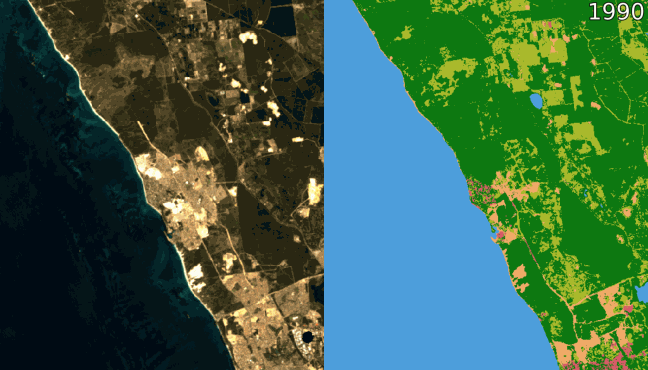Digital Earth Australia Land Cover enhances Australia’s image from space
Page last updated:6 March 2025
Learn about how DEA Land Cover data is produced, and what it is used for
Now available in version 2.0, DEA Land Cover provides a comprehensive photo portrait of Australia made possible by nearly four decades of Earth observation data
Geoscience Australia is excited to announce the release of DEA Land Cover 2.0, incorporating the latest U.S. Geological Survey (USGS) Landsat data, including enhancements from Landsat 9, for improved accuracy and detail. This new version, available through the DEA Maps and the Digital Atlas of Australia offers greater understanding of Australia’s diverse landscapes over 35 years.
DEA Land Cover 2.0 provides a detailed classification of Australia’s land cover, using satellite data to map the physical characteristics of the Earth’s surface. From vegetation and built structures to bare ground and waterbodies, this data is crucial for monitoring ecological changes, managing natural resources, and understanding landscapes shift over time.
“DEA Land Cover 2.0 provides a comprehensive view of how landscapes evolve over time,” explains Dr Cedric Jorand, Manager of Terrestrial Environments in Geoscience Australia.
“We can see every patch of land across the entire continent, tracking changes year by year since 1988.
“If we take Quinn's Rock in Western Australia as an example, DEA Land Cover data shows how this suburb has grown between 2000 and 2020. The data reveals the clearing of surrounding vegetation, initially classified as green pixels, transforming into bare surfaces shown in sandy colours. Eventually, these areas were developed into urban surfaces, which are depicted as pink pixels.
“By classifying every 30 x 30m patch of land across the country annually since 1988 to the present, DEA Land Cover 2.0 offers insights into trends in land use. This data is crucial for understanding how urban areas expand, how natural landscapes are altered, or how our water bodies have evolved through historic natural events such as the Millennial Drought, the 2019-2020 bushfires or the 2020-2021 La Niña event”.
“The ability to track these changes over time makes the DEA Land Cover product an essential tool for urban planners, environmentalists, and policymakers,” said Dr Jorand.
The latest version of DEA Land Cover introduces several new features and improvements:
- Medium resolution: Characterises any 30 square meters of Australia, providing detailed insights into vegetation, soil, water, land, crop, and grazing management.
- Long term data: Offers data for any area of Australia from 1988 to present day.
- Policy and land management: Enables agencies, land managers, and scientists to analyse land conditions over large areas and long timeframes.
- Enhanced cloud masking: Reduces noise and improves data quality.
- Inclusion of Landsat 9: Provides better performance with more observations.
- Collection Upgrade: Based on the latest Geoscience Australia's Landsat Collection 3 Analysis Ready Data.
DEA Land Cover is already being utilised by various government entities and businesses, including the Commonwealth Department of Environment, Climate Change, Energy and Water, and the Australian Bureau of Statistics. These organisations use the data for environmental analysis, agricultural census, and land accounts.
“Understanding land cover is crucial for managing our natural resources and planning for the future,” says Dr Cedric Jorand. “With DEA Land Cover 2.0, we can provide accurate and up-to-date information that supports sustainable development and environmental management and conservation.”
As part of the 2.0 release, DEA Land Cover data will be the second set of Australia’s Earth observation data to join DEA Coastlines into the Digital Atlas of Australia. The Digital Atlas is an interactive, secure and easy-to-use platform where you can explore, analyse and visualise DEA Land Cover with other trusted national datasets.
DEA Land Cover users will continue to have access through DEA Maps, a user-friendly interactive interface that allows users to view and analyse the DEA Land Cover data and visualise and explore a wide range of other geospatial data. It also provides access to other DEA products.
The DEA Knowledge Hub provides ongoing support for technical users. The DEA Knowledge Hub is a central repository where users can find comprehensive information on DEA products and services. It brings together user guides, data product information, DEA Notebooks, and more into one easily accessible location.
We ask you to be curious and learn more about how DEA Land Cover can benefit and integrate into your work. For more information, visit the Digital Earth Australia website at https://www.dea.ga.gov.au/.
